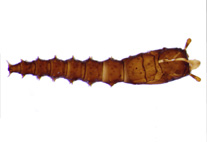Abstract
The pupae of species in each of the 45 genera of Ceratopogonidae known in this stage are diagnosed and described. A standard set of terms is provided, with a glossary, for all pertinent structures of the pupal stage within a context of other Culicomorpha. The variety of terms provided by previous authors are synonymized. Some pupal structures are directly related to developing adult structures and these are discussed. A key to the genera (and to the subgenera of Forcipomyia Meigen) allows for their identification. Pupation and pupal behaviour is summarized. A table of all previous descriptions of each stage of the immatures (egg, larva, pupa) is provided, showing that 13% of all validly named extant Ceratopogonidae are known as pupae. This study examined 45% of these species. All species known as fossil pupae are discussed.
A phylogenetic analysis based primarily on pupal characters confirms the relationships between the subfamilies as well as the relationships between the genera in Leptoconopinae, Forcipomyiinae and Dasyheleinae. The question of the monophyly of the Culicoidini remains unresolved. Results confirm the paraphyly of the Ceratopogonini and, for the first time, the Sphaeromiini sensu lato, which is divided into Hebetulini (new tribe), Johannsenomyiini Crampton (new status) and Sphaeromiini sensu novum. Sphaeromiini sensu novum includes Sphaeromias Curtis, Leehelea Debenham, Homohelea Kieffer and Xenohelea Kieffer and forms the sister group of the Palpomyiini. Other genera in Sphaeromiini sensu lato not known as pupae are discussed. The genus Mallochohelea Wirth is shown to be polyphyletic and one group of species is therefore recognized as members of the new genus Anebomyia (type species = Mallochohelea atripes Wirth). A number of species previously placed in Stilobezzia Kieffer are shown to belong to Schizonyxhelea Clastrier. Study of the type species of the monotypic genus Nemoromyia Liu and Yu showed it to be a member of the Palpomyia distincta species group and the generic name is therefore a new junior synonym of Palpomyia.
Examination of pupae showed that the following species were misplaced and are now in other genera as follows: Schizonyxhelea brevicostalis (Das Gupta & Wirth), 1968: 28 (Stilobezzia) new combination, Schizonyxhelea bulla (Thomsen), 1935: 289 (Stilobezzia) new combination, Schizonyxhelea caribe (Lane & Forattini), 1958: 208 (Stilobezzia) new combination, Schizonyxhelea diminuta (Lane & Forattini), 1958: 209 (Stilobezzia) new combination, Schizonyxhelea obscura (Lane & Forattini), 1958: 216 (Stilobezzia) new combination, Schizonyxhelea panamensis (Lane & Forattini), 1958: 218 (Stilobezzia) new combination, Schizonyxhelea thomsenae (Wirth), 1953: 83 (Stilobezzia) new combination, Schizonyxhelea scutata (Lane & Forattini), 1961: 92 (Stilobezzia) new combination, Pellucidomyia geari (de Meillon & Wirth), 1981: 547 (Macropeza) new combination, Dibezzia prominens (Johannsen) 1932: 435 (Johannsenomyia) new combination, Nilobezzia theileri (de Meillon & Wirth, 1981:552) (Sphaeromias) new combination, Anebomyia atripes (Wirth, 1962: 281) (Mallochohelea) new combination, Anebomyia fluminea (de Meillon & Wirth), 1981: 550 (Mallochohelea) new combination, Anebomyia siricis (de Meillon), 1961: 50 (Sphaeromias) new combination, Anebomyia texensis (Wirth), 1962: 283 (Mallochohelea) new combination, Anebomyia yunnana (Yu & Zou), in Yu et al. 2005: 1503 (Mallochohelea) new combination, Bezzia goezii (Schrank), 1803: 72 (Tipula) new combination (also a nomen nudum), Palpomyia nemorosa (Liu & Yu), 1991: 26 (Nemoromyia) new combination. Bezzia xanthogaster (Kieffer), 1919: 130 (Probezzia) is a junior homonym of Probezzia xanthogaster (Kieffer), 1917: 329 (Bezzia) and is here given the new name Bezzia gilvigaster Borkent. The fossil genus Paraculicoides Pierce, 1966: 94 and its type species Paraculicoides rouseae Pierce, 1966: 94 are removed from the Ceratopogonidae and likely belong in the Psychodidae.

